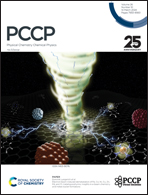A quantum-chemical insight into SOMO–HOMO conversion in phosphorus–boron cation radicals†
Abstract
Organic radicals exhibiting SOMO–HOMO conversion (SHC) electronic configurations have recently garnered increasing attention due to their exceptional stability and photophysical properties. In this study, we investigate two series of phosphorus–boron cation radicals based on 1,3,5-trimethylphenyl units substituted with P and B atoms, varying numbers of P–B moieties, and π-conjugation linkers. We perform quantum-chemical calculations to systematically assess the influence of chemical substituents on the SHC electronic structural features. Our computational results demonstrate that the SHC electronic configurations of the studied complexes are primarily determined by the number of P–B moieties, specifically, phosphorus–boron cation radicals with two P–B moieties as terminal groups in π-conjugation linkers, which efficiently arrange electrons to increase HOMO energies compared to corresponding radicals with only one P–B unit. Furthermore, spin density distributions change as the size of π-conjugation linkers increases. Natural bond orbital (NBO) and atoms-in-molecules (AIM) analyses reveal strong intramolecular charge transfer between P and B atoms along with other stabilized donor–acceptor interactions and significant covalent bonds between P and B atoms. Moreover, synergistic effects resulting from 1,3,5-trimethylphenyl substitutions and enlarged π-conjugation linkers containing P–B units confer excellent photophysical properties upon these studied radicals, making them potential stable radicals in optoelectronic applications.



 Please wait while we load your content...
Please wait while we load your content...